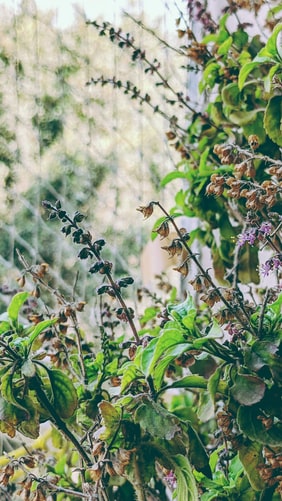Many Indian households grow the tulsi or basil plant as a traditional practice. Apart from being worshiped, it is also used in a variety of grandma’s cures.

Tulsi: A Profile
Latin Name: Ocium tenuiflorum Linn (Ocimum sanctum Linn)
Regional Names: Tulsi, Kali tulsi, Krishna tulsi, Siva tulsi, etc .
Family Appearance: Erect, aromatic, hairy subshrub small flowers, purplish
Tulsi: How to use it
| Ailment | Prescription |
| Skin diseases | Tulsi leaf juice taken internally and applied externally. |
| Cold, stomach upset | Tulsi leaves boiled with water. |
| Aphrodisiac | Powdered root with clarified butter (ghee). |
| Stomach trouble (even in infants and little children) | Paste of seed with milk |
| Cold, pain in ribs, cardiac pain, low blood pressure, influenza, worms, skin diseases, urinary diseases | Leaf juice (10-15 leaves) mixed with a spoonful of honey. |
| Cold and cough (alternatively chew on 15-20 tulsi leaves frequently with jaggery) | Leaf-juice (10-15 leaves) with a spoonful each of the ginger and betel leaf mixed with a spoonful of honey. |
| Stomach-ache, gastroenteritis, gas problem, digestion problems, dysentery | A decoction of 15-20 leaves, taken along with rock salt. |
| Guards against malaria | A decoction of 15-20 tulsi leaves taken along with pepper powder. |
| Prevention of cold, nutritive value to children | 10 leaves boiled in cow’s milk. |
| Longevity, rejuvenation | 5 leaves eaten along with water every morning on an empty stomach continuously for 108 days. |
| Fevers caused by pitta aggravation | Twenty leaves and ginger (one-inch size) crushed, mixed with 1 cup water, boiled to half-a-cup. Take two table spoons of it three times daily. |
| Chest diseases, fever due to T.B. | Twenty leaves crushed and mixed in 2 cups water, boiled to 1 cup. Add to this 15gm mishri and two teaspoon honey. Take two table spoons 4 times a day. |
| Toxic fevers | Take 51 big leaves. Mix with 21 pepper seeds and make a paste. Roll it to small pills of the size of a pepper. One such pill is to be taken once in the evening. |
| Unpleasant body odour | 20 leaves eaten with a glass of water every morning for a month. |
| Headache | Occasionally, dried leaf powder snuffed. |
| Headache | Mix 10-15 leaves with four cloves and a little dry ginger. Grind and apply on forehead. |
| Ear diseases | Leaf juice used as ear drops. |
The Plucking Ritual
The Indian civilisation believes, as scientists have proved, that plants do have a sense of feel. While plucking flowers or leaves, violence should be avoided. One should only pluck the required amount of leaves. No leaves are to be plucked after sunset and it is best to water the plant before doing so.
Caution
Any plant substance, whether used as food or medicine, externally or internally can cause allergic reaction in some people. It is advised not to try self-diagnostic or attempt self-treatment without consulting a medical professional or qualified practitioner.
References
Das, S.K., et al. 1983. Tulsi in the treatment of viral encephalitis, Antiseptic, 80(7), 323-327.
Sharma, R., et al. 1987. Management of tropical pulmonary eosinophilia in children with Ayurvedic drugs, ]our. of Res. and Edn. in Ind. Med., 6(1- 2), 11-17.
Matsubiro, A and Nakada, D., 1955. Short note on anti-tuberculous substances of Tulsi, 1955 .Antibiotic Chemotheraphy,5(22), Chem. Abstr., 1955, 49, 6368 d.
Hartwel, J.L. 1969. Plants used against cancer, a survey, Lloydia, 32-247.
Reddi, G.S., et al. 1986. Chemotherapy of tuberculosis- Anti tubercular activity of Tulsi leaf extract. Filoterapia, 57-114. Grover, G.S. and Rao, J.T.1977. Investigations on the anti-microbial efficacy of essential oils of Tulsi. Parfum Kosmet, 58-326.
Sharma, G. 1983. Anti-asthmatic-efficacy of Tulsi. Sachitra Ayurved, 35(10).
